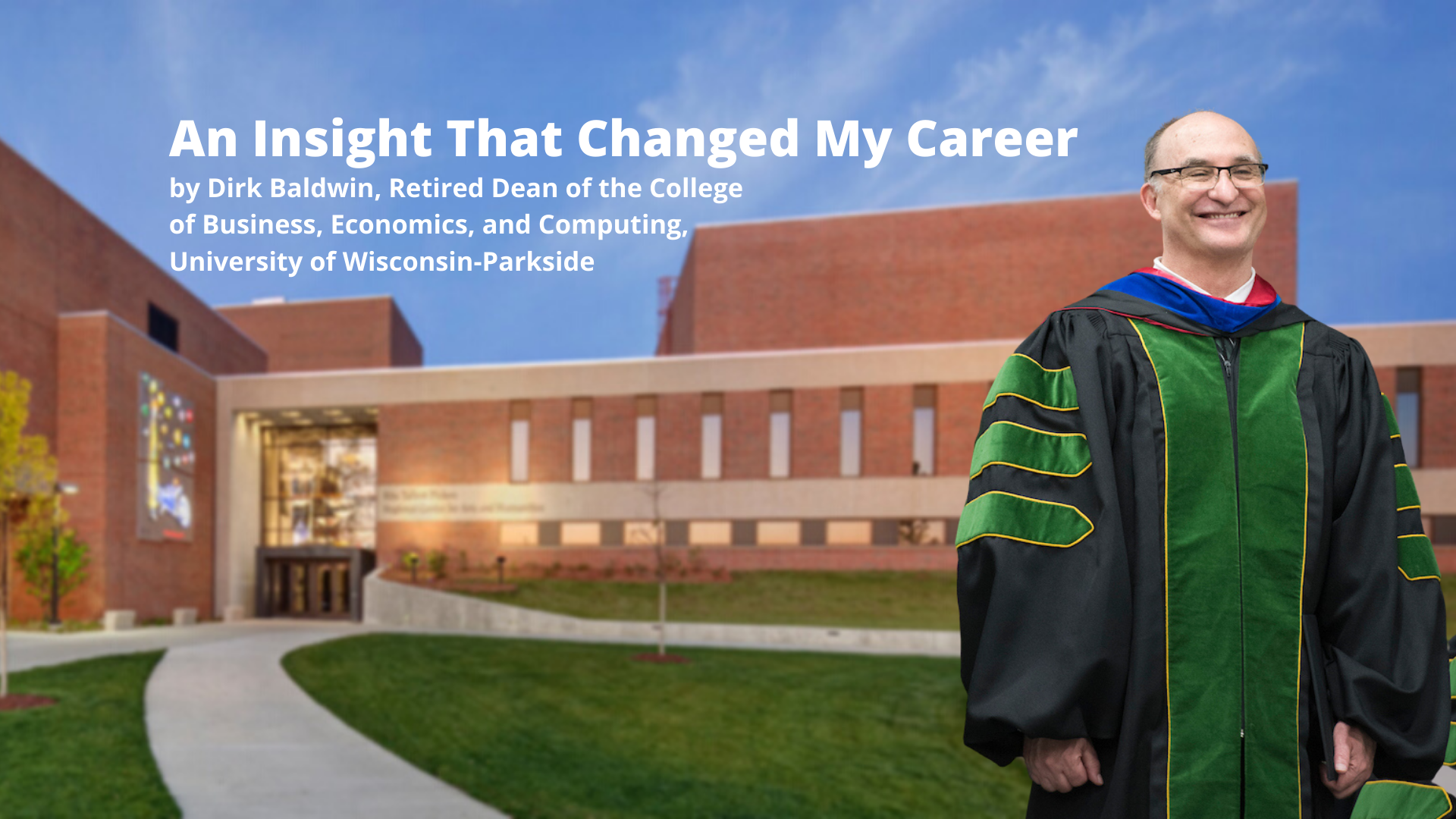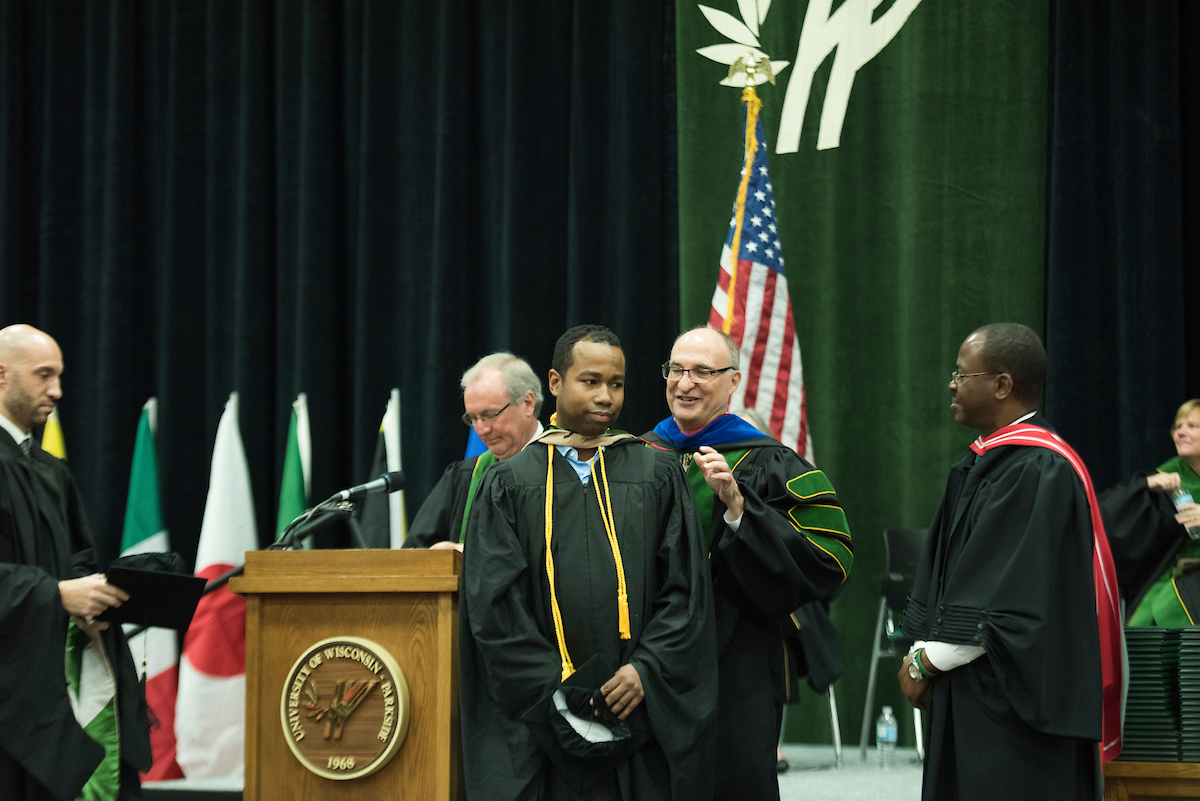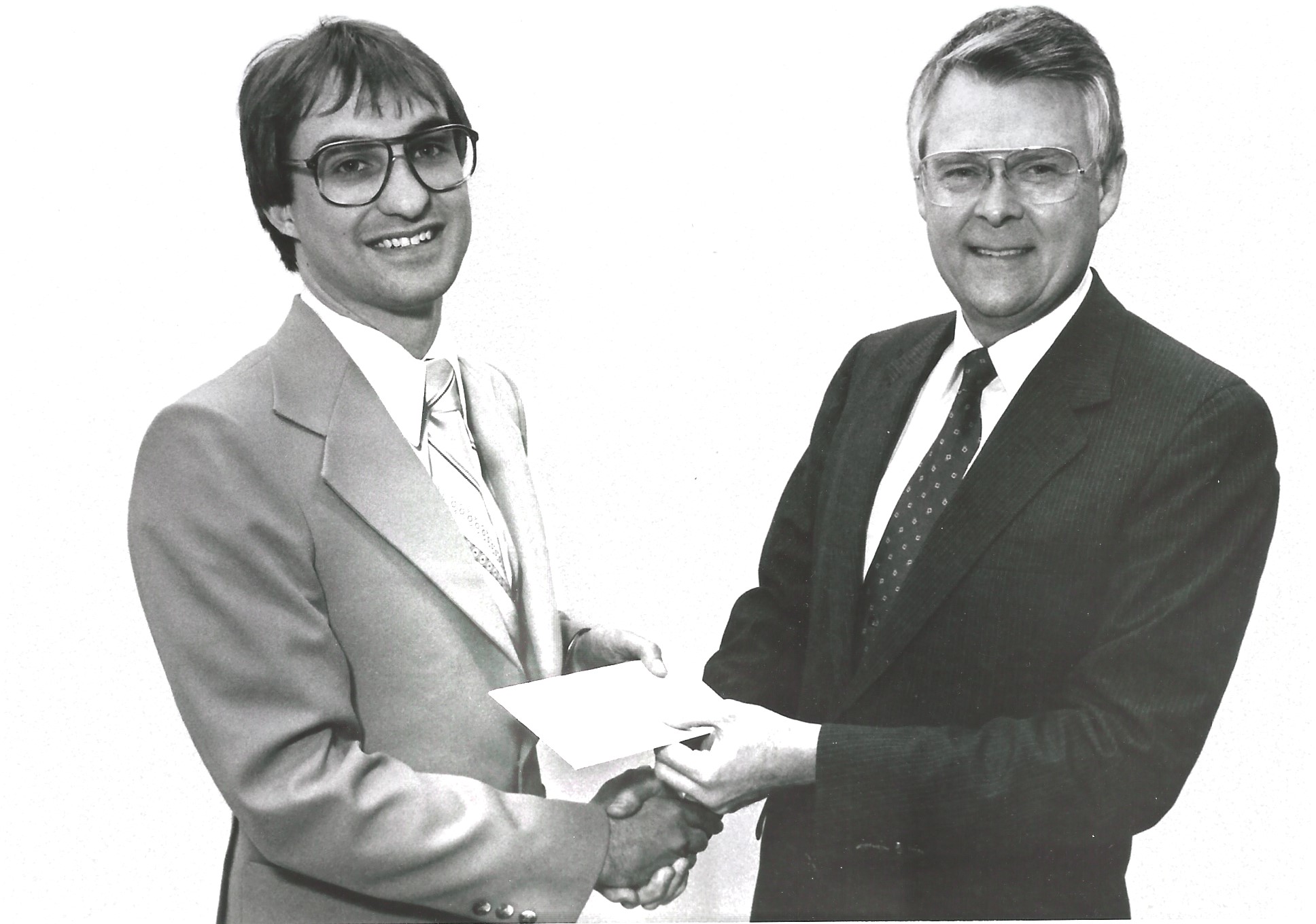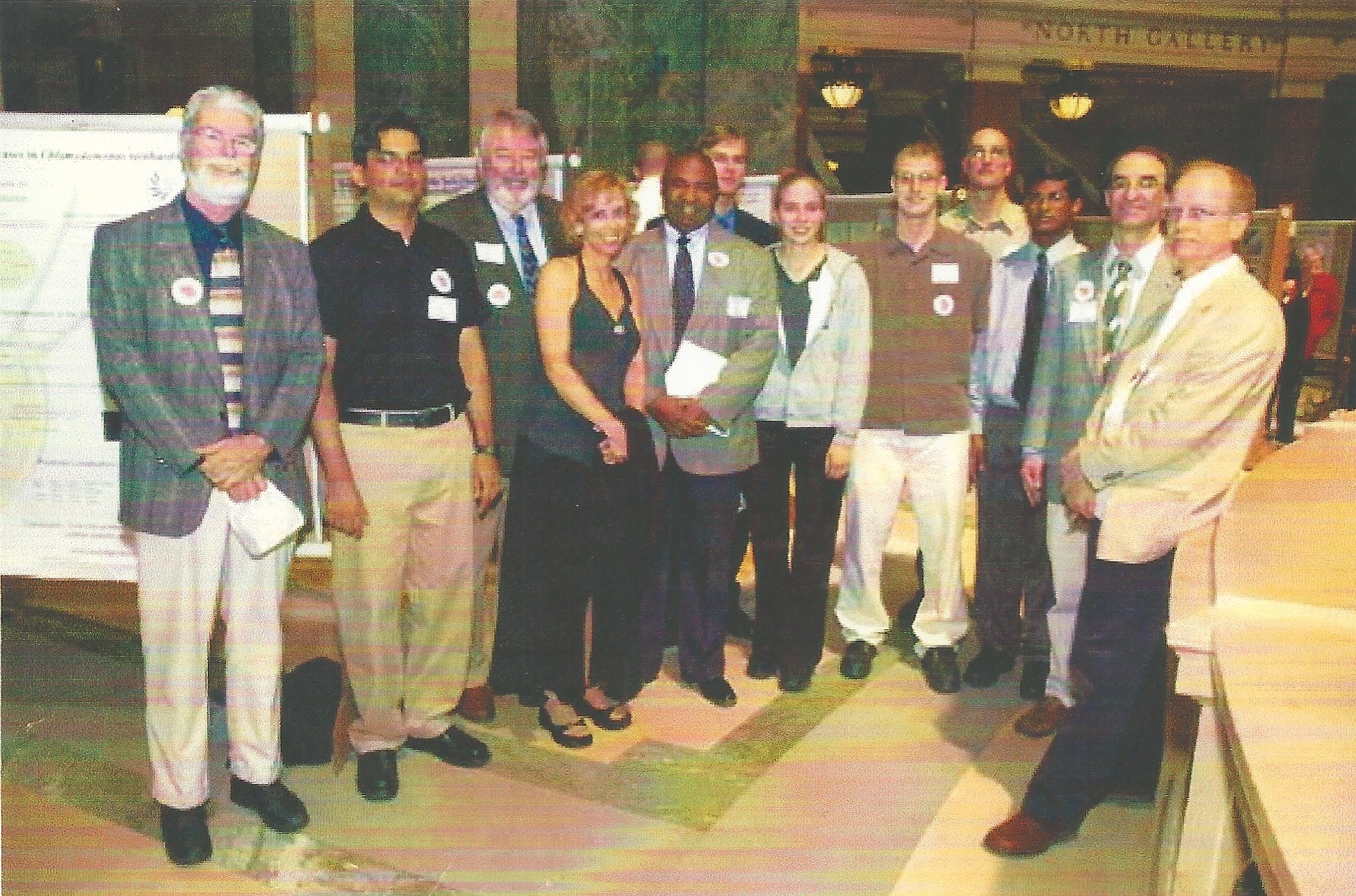
An Insight That Changed My Career
By Dirk Baldwin, Retired Dean of the College of Business, Economics, and Computing, University of Wisconsin-Parkside.
I didn’t plan to be part of the great resignation. I just thought it was time for something new. So, in August 2021 I retired as dean of the College of Business, Economics, and Computing at the University of Wisconsin-Parkside (UWP). I had been at UWP since 1996; starting as an associate professor of management information systems (MIS) and ultimately taking on the dean’s position in 2012.
I wasn’t always at UWP. I was a professor at Virginia Tech and then Texas Tech. My first experience with computers was in high school. Programming consisted of wiring a circuit board. I advanced to programming through punch card decks at UW-Madison and eventually used “dumb” terminals to program mainframes and minicomputers at UW-Madison and the University of Texas.
Technology has certainly changed higher education. I started writing papers on a typewriter and learned to use a markup language for word processing on a minicomputer. My higher education history has seen the rise of minicomputers, desktop computers, large portable computers, networks, Internet, laptops, wireless networks, tablets, and smartphones. All of these have been incorporated into higher education. Technology has significantly changed administrative functions (e.g., registration, transcripts), research, and learning.
Perhaps because of my interest in computers, I always tried to be toward the leading edge of technology in my classes. Many years ago I taught web design to my freshman seminar students because I thought it would be fun and a practical way for students to describe their experience at UWP. I think my students appreciated it, but I’m not sure that they thought learning HTML was fun.
Although incorporating technology into learning was an important part of my teaching style, I don’t think that technology made the biggest impact. The biggest impact occurred on the day I learned that I was the “odd” one.
I have a feeling that many students at a university have already hypothesized that learning how to teach is not the primary subject of their professors’ studies. In fact, unlike K-12 teachers, professors receive very little education on teaching methodology as they pursue their graduate degrees. I had one class on teaching, and it met a total of three times during the semester. The curriculum for PhD students primarily focuses on their subject area and research. This is not necessarily a bad thing. Research is what keeps professors current and knowledgeable of new advances in their respective fields.

Nevertheless, I remember querying my friends, “Do you think we should have more classes on how to teach?” One of them answered, “No, you have had so many different instructors in undergraduate and graduate programs that you should be able to draw from your experiences. Ask yourself, what worked for you?” The comment made sense to me.
That is, the comment made sense to me until I completed the one required exercise in my teaching class. We were required to take surveys on personality and learning styles. Prior to Buzzfeed and the Hogwarts House Quiz, personality and learning instruments were primarily associated with teacher education, psychology, and human resource departments. The surveys were completed with number two pencils on scantron bubble sheets. About a week after the scantrons were submitted, you received your results. The results tended to classify participants into categories, for example: Introvert or Extrovert, Thinking or Feeling, Visual or Verbal, Actively or Reflectively, Concrete or Abstract, etc.
One of the most well-known and earliest surveys is the Myers-Briggs. This instrument was first published by a mother (Katharine Briggs) and daughter (Isabell Briggs Myers) in 1944. Catherine Brigg’s began her research on personality after she recognized that Isabell’s fiancé had a significantly different personality from the rest of the family. Since 1960 over 50 million people have taken the Myer-Briggs assessment.
Many other instruments exist. These instruments have been studied and critiqued in hundreds of academic papers. Some people think that the instruments are useful for predicting and explaining workplace performance and some think they are not relevant. Similarly, many people believe that taking into account learning styles is important and some people believe that there is little evidence that it is effective. Still, the instruments are widely used and the concepts, in general, have been adopted by businesses and educational providers.
The revealing part for me was my categorization compared to others. I was grouped into a category that tended to learn through reading, conceptualization, intuition, and understanding fundamental principles that could later be applied to concrete experiences. I was similar to many other PhD students. After plotting scores of my fellow PhD students, the instructor displayed a chart showing the distribution of everyone else. The plot showed students distributed across categories with the least density in “my” category and the greatest density almost completely opposite. Many students learned through concrete examples and verbally. I was the odd one. The students who I perceived as not working hard, worked hard but tended to learn in a different manner than me!
In retrospect, I should have known I was unusual. When I was in elementary school, for fun, I solved math problems in workbooks purchased by my parents. In high school and college, I read the material before class. I hoped that this would help me understand basic concepts prior to class, so that I could better understand advanced concepts taught in lecture. I took third semester calculus even though it wasn’t required for my major.

Although I still loved to teach theoretical concepts that formed the basis for computer design, I knew that I could not, as my friend suggested, teach a class the way I liked to learn. I needed to reach my students through a variety of learning methods. This led to a lot of experimentation. Sometimes a lesson worked and sometimes it didn’t. Truthfully, I think many of my students liked to see me fail. When this happened, we frequently laughed it off and tried again. FAIL, incidentally, is an acronym I like attributed to A. P. J. Abdul Kalam: First Attempt in Learning.
In many classes I attempted to teach by providing fun and concrete examples. For example, we demonstrated quality control by counting the colors in bags of M&Ms and comparing the results to the published distribution. As another example, I bet classes of approximately 35 students that at least two people in the class shared the same birthday. I almost always won the friendly bet because the probability of two people sharing the same birthday in a class of 35 is 81%. Of course, then I showed them how to derive the probabilities through an Excel spreadsheet.
I have fond memories of paper airplane throwing contests. I used these contests to demonstrate the advantage of planning, teamwork, feedback, and several other concepts that depended on the class. I noticed that students in the College of Business, Economics, and Computing were not skilled in folding paper airplanes, and I believe the skill declined over the years. My suspicion is that students had become more adept at computer games rather than the paper games of my youth. In one class, a student team wadded up a piece of paper into a ball, threw it and won the contest. I had to introduce the rule that the paper airplane had to sort of look like a paper airplane. Another team affixed a pen to the paper airplane. It flew very well but it was a basically a projectile that could poke out an eye. At least it allowed me to bring in the importance of the Consumer Product Safety Commission. I created another rule that paper airplanes had to be made only of paper. Regardless, I was pleased with my students’ ingenuity.
Probably the greatest change I made, however, is requiring live projects. Beginning with my teaching assistant (TA) experience and continuing through employment at all of my universities, my students found a real client, analyzed their information systems needs, and proposed a design that met their needs. At UW-Parkside, I also began to require that the students build a prototype or implement an actual system. Students have proposed and/or developed systems for small businesses, large companies, non-profits, and government agencies. My UWP students developed websites and systems including those that support asset management, budgets, shuttle reservations, quality control, advertising of services, and client tracking. One of my students at Virginia Tech presented a design to modernize the U.S. Patent Office. Working with real clients, rather than made-up book problems, allowed the students to learn how conceptual concepts applied to the real world. In addition, students learned soft skills (e.g.., teamwork, communication), project management skills, and the value of work to business and society. The students would also have a project that they could discuss in interviews and document on their resume.

At my previous universities, live projects were a bit of a novelty, but at UWP I found myself as part of a budding movement. Due to the foresight of several, UWP began to focus on community-based learning as a high impact practice. UWP became the first university in the state of Wisconsin to be Carnegie Classified as Community Engaged.
Working with the community helped me to meet many community leaders. With Stephen Hawk, Professor of MIS, and Cory Mason, CIO at Harley Davidson at the time, I helped create and chair the Information Technology Practice Center (ITPC); a center dedicated to community projects and furthering the pipeline of IT talent to the region. Students regularly present their projects to the ITPC board.
The ITPC led to the development of the Ralph Jaeschke Solutions for Economic Growth (SEG) Center. This organization is similar to the ITPC but manages projects throughout the entire college, including projects related to marketing, business process improvement, and business plans. Approximately 400 students work on 100 community projects through the SEG Center each year.
The ITPC and SEG Center led to the development of the App Factory. The App Factory pays students to develop mobile apps for paying customers and hires students in computer science, business, graphic design, and geographic information systems. The App Factory is a primary source of app development across the UW-System and has won an international award for innovation in education. The App Factory develops professional, high-quality apps for its customers, but more importantly helps students learn concepts and skills that form the foundation for a career.
Community-based learning is an example of a high impact practice: a practice that leads to enhanced student engagement, deep learning, and improved graduation rates. Other examples include undergraduate research, study abroad, and participating in student competitions. Although technology has had a significant impact on higher education, I believe the greatest change I have witnessed over my career, especially at UWP, is an explicit drive for student success. Teaching and Learning Centers provide programs and consulting for faculty to help them improve their classes, The Office of Professional and Instructional Development performs a similar service at UW System.
One of the greatest impacts of technology has been software that helps us track students’ performance, communicate with those who may be struggling, and highlight classes that appear to be difficult. Software is being used to help reach and teach non-traditional students who desire to obtain a higher education. These efforts have been successful. Although the number of students enrolled at UWP has declined, the number of graduates per semester continues to climb.
Technology has certainly had a major impact on higher education. However, just as Katherine Brigg’s was inspired to create a test from observations of the personality of Isabell’s fiancé and I had an idea to change my teaching style based on these types of tests, changes to universities are the result of ideas. Universities realize that in order to contribute to their communities and survive, more students need to learn and successfully obtain degrees. Delivering on that idea is the key to success. Technology is one of the tools that help universities deliver.
As I look back on my career, I am proud of the students who worked on community projects, the community that helped the students learn, the students who graduated and made a difference in their communities, and the innovative faculty who continue to advance student success today.
